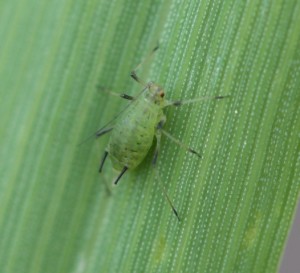I discussed the value of insecticide seed treatments for wheat in a previous article. In a nutshell, seed treatments offer the greatest value for wheat planted before the recommended fly-free date (approximately October 15th in Tennessee). A post-emergence foliar approach is a very viable option if seed treatments are not used. However, if you plan on using a seed treatment, I’ve included a list of recommended products and use rates for the control of aphids (below). All should help reduce fall transmission of barley yellow dwarf virus by aphids.

Gaucho 600
- Active ingredient – Imidacloprid
- 0.8 – 2.4 fl oz per 100 lb seed
Cruiser 5 FS
- Active ingredient – Thiamethoxam
- 0.75 – 1.33 fl oz per 100 lb seed
NipsIt Inside (5F)
- Active ingredient – Clothianidin
- 0.75 – 1.79 fl oz per 100 lb seed
All three of these products contain 5 lbs of active ingredient per gallon and have a similar mode of action. The typical use rates applied by distributors is in the range of 0.8 – 1.0 oz of product per 100 pounds of seed. However, the highest labeled rates are recommended for control of Hessian flies. You should consider using these higher rates if you intend to plant before the recommended planting date. Be advised that seed treatments should not be expected to control fall armyworms that sometimes infest early planted wheat.
Buyer Beware: Insecticide seed treatments are sometimes packaged with fungicides (see related article by Dr. Heather Young Kelly). But you will not get the recommended insecticide rate if applying some of these pre-packaged seed treatments at the labeled rate. For example, “CruiserMaxx for Cereals” and “NipsIt Suite for Cereals” contain insecticide in a much more dilute form than found in Cruiser 5F or NipsIt Inside. It would be necessary to add additional insecticide to achieve the equivalent insecticide rates listed above.


One thought on “Insecticide Seed Treatment Options for Wheat”
Comments are closed.